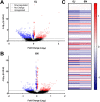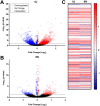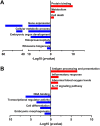Transcriptomic analyses of gastrulation-stage mouse embryos with differential susceptibility to alcohol
- PMID: 34137816
- PMCID: PMC8246266
- DOI: 10.1242/dmm.049012
Transcriptomic analyses of gastrulation-stage mouse embryos with differential susceptibility to alcohol
Abstract
Genetics are a known contributor to differences in alcohol sensitivity in humans with fetal alcohol spectrum disorders (FASDs) and in animal models. Our study profiled gene expression in gastrulation-stage embryos from two commonly used, genetically similar mouse substrains, C57BL/6J (6J) and C57BL/6NHsd (6N), that differ in alcohol sensitivity. First, we established normal gene expression patterns at three finely resolved time points during gastrulation and developed a web-based interactive tool. Baseline transcriptional differences across strains were associated with immune signaling. Second, we examined the gene networks impacted by alcohol in each strain. Alcohol caused a more pronounced transcriptional effect in the 6J versus 6N mice, matching the increased susceptibility of the 6J mice. The 6J strain exhibited dysregulation of pathways related to cell death, proliferation, morphogenic signaling and craniofacial defects, while the 6N strain showed enrichment of hypoxia and cellular metabolism pathways. These datasets provide insight into the changing transcriptional landscape across mouse gastrulation, establish a valuable resource that enables the discovery of candidate genes that may modify alcohol susceptibility that can be validated in humans, and identify novel pathogenic mechanisms of alcohol. This article has an associated First Person interview with the first author of the paper.
Keywords: Apoptosis; Brain development; Embryo; Fetal alcohol spectrum disorders; Inflammation.
© 2021. Published by The Company of Biologists Ltd.
Conflict of interest statement
Competing interests The authors declare no competing or financial interests.
Figures







Similar articles
-
Knockdown of Mns1 Increases Susceptibility to Craniofacial Defects Following Gastrulation-Stage Alcohol Exposure in Mice.Alcohol Clin Exp Res. 2018 Nov;42(11):2136-2143. doi: 10.1111/acer.13876. Epub 2018 Sep 10. Alcohol Clin Exp Res. 2018. PMID: 30129265 Free PMC article.
-
Transcriptome-Wide Regulation of Key Developmental Pathways in the Mouse Neural Tube by Prenatal Alcohol Exposure.Alcohol Clin Exp Res. 2020 Aug;44(8):1540-1550. doi: 10.1111/acer.14389. Epub 2020 Jul 1. Alcohol Clin Exp Res. 2020. PMID: 32557641 Free PMC article.
-
The pro-apoptotic Bax gene modifies susceptibility to craniofacial dysmorphology following gastrulation-stage alcohol exposure.Birth Defects Res. 2022 Nov 15;114(19):1229-1243. doi: 10.1002/bdr2.2009. Epub 2022 Apr 9. Birth Defects Res. 2022. PMID: 35396933 Free PMC article.
-
The chick embryo as a model for the effects of prenatal exposure to alcohol on craniofacial development.Dev Biol. 2016 Jul 15;415(2):314-325. doi: 10.1016/j.ydbio.2016.01.007. Epub 2016 Jan 14. Dev Biol. 2016. PMID: 26777098 Review.
-
Human gastrulation: The embryo and its models.Dev Biol. 2021 Jun;474:100-108. doi: 10.1016/j.ydbio.2021.01.006. Epub 2021 Jan 20. Dev Biol. 2021. PMID: 33484705 Review.
Cited by
-
Prenatal alcohol exposure disrupts Sonic hedgehog pathway and primary cilia genes in the mouse neural tube.Reprod Toxicol. 2021 Oct;105:136-147. doi: 10.1016/j.reprotox.2021.09.002. Epub 2021 Sep 4. Reprod Toxicol. 2021. PMID: 34492310 Free PMC article.
-
Neuroimmune Activation and Microglia Reactivity in Female Rats Following Alcohol Dependence.Int J Mol Sci. 2024 Jan 28;25(3):1603. doi: 10.3390/ijms25031603. Int J Mol Sci. 2024. PMID: 38338883 Free PMC article.
-
Pharmacological activation of the Sonic hedgehog pathway with a Smoothened small molecule agonist ameliorates the severity of alcohol-induced morphological and behavioral birth defects in a zebrafish model of fetal alcohol spectrum disorder.J Neurosci Res. 2022 Aug;100(8):1585-1601. doi: 10.1002/jnr.25008. Epub 2022 Jan 11. J Neurosci Res. 2022. PMID: 35014067 Free PMC article.
-
The neuroimmune system - Where aging and excess alcohol intersect.Alcohol. 2023 Mar;107:153-167. doi: 10.1016/j.alcohol.2022.08.009. Epub 2022 Sep 21. Alcohol. 2023. PMID: 36150610 Free PMC article. Review.
-
Chronic alcohol exposure during young adulthood attenuates microglial reactivity and downstream immune response pathways in a mouse model of tauopathy later in life.Alcohol Clin Exp Res (Hoboken). 2025 May;49(5):985-1000. doi: 10.1111/acer.70034. Epub 2025 Mar 21. Alcohol Clin Exp Res (Hoboken). 2025. PMID: 40114609
References
-
- Aoto, K., Shikata, Y., Higashiyama, D., Shiota, K. and Motoyama, J. (2008). Fetal ethanol exposure activates protein kinase A and impairs Shh expression in prechordal mesendoderm cells in the pathogenesis of holoprosencephaly. Birth Defects Res. A Clin. Mol. Teratol. 82, 224-231. 10.1002/bdra.20447 - DOI - PubMed
Publication types
MeSH terms
Substances
Grants and funding
LinkOut - more resources
Full Text Sources
Molecular Biology Databases

